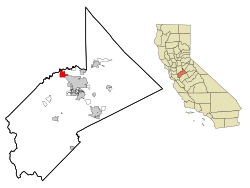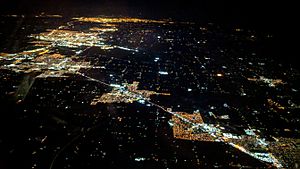Salida, California facts for kids
Quick facts for kids
Salida
|
|
|---|---|
| Motto(s):
Salida Welcomes You!
|
|

Location in Stanislaus County and the state of California
|
|
| Country | United States |
| State | California |
| County | Stanislaus |
| Railroad station | 1870 |
| Area | |
| • Total | 5.571 sq mi (14.430 km2) |
| • Land | 5.320 sq mi (13.780 km2) |
| • Water | 0.251 sq mi (0.650 km2) 4.50% |
| Elevation | 69 ft (21 m) |
| Population
(2020)
|
|
| • Total | 13,886 |
| • Density | 2,492.55/sq mi (962.30/km2) |
| Time zone | UTC-8 (Pacific (PST)) |
| • Summer (DST) | UTC-7 (PDT) |
| ZIP code |
95368
|
| Area code | 209 |
| FIPS code | 06-64210 |
| GNIS feature ID | 1659792 |

Salida is a community in Stanislaus County, California, in the United States. Its name comes from the Spanish word for "Exit." In 2010, about 13,722 people lived here. Salida is part of the larger Modesto area.
A big part of the local economy is growing almonds. A large Blue Diamond factory nearby processes these almonds. They use a "dry" method, which means no water or chemicals are used. Salida is also part of an area that works to protect the environment and use good farming practices.
Contents
What Does the Name Salida Mean?
The name "Salida" was given by the Southern Pacific Railroad in 1870. It means "departure" or "exit" in Spanish.
A Look Back at Salida's History
In 1870, the Central Pacific Railroad built its tracks to the northern part of Stanislaus County. They set up a railroad station there and named it salida. This Spanish name, meaning "exit," fit well because the nearby town of Modesto also has a Spanish name. The town was even designed in a triangle shape!
Later, in 2012 and 2013, there were talks about Salida joining the city of Modesto. However, many local residents did not want this to happen.
Exploring Downtown Salida
The Downtown area of Salida is located where the original town was first planned. Many government buildings and shops are found along Broadway. In the middle of Broadway, there are oak trees and a nice walking trail for people to enjoy.
Where is Salida Located?
Salida is located in California at these coordinates: 37.709877 degrees North and -121.089286 degrees West.
The community covers a total area of about 5.6 square miles (14.4 square kilometers). Most of this area, about 5.3 square miles (13.7 square kilometers), is land. The rest, about 0.25 square miles (0.65 square kilometers), is water.
How Many People Live in Salida?
| Historical population | |||
|---|---|---|---|
| Census | Pop. | %± | |
| 2010 | 13,722 | — | |
| 2020 | 13,886 | 1.2% | |
| U.S. Decennial Census | |||
In 2010, Salida had a population of 13,722 people. Most of the people lived in homes. About 99.5% of the population lived in households.
There were 3,933 households in Salida. Many of these households, about 54.3%, had children under 18 living in them. The average household had about 3.47 people.
The population included people of all ages. About 32% of the people were under 18 years old. The median age in Salida was 31.2 years. This means half the people were younger than 31.2, and half were older.
Schools in Salida
The Salida School District helps educate many students. For the 2010–2011 school year, there were 2,759 students. The district also had 100 teachers, 112 support staff, and 8 administrators.
The Salida School District has four elementary schools and one middle school for grades 6-8. Modesto City Schools also runs one high school in Salida for grades 9-12. All these schools follow a regular school calendar.
Elementary Schools
- Dena Boer Elementary School
- 4801 Gold Valley Road, Salida, CA 95368
- Phone: 209-543-8163
- Sisk Elementary School
- 5337 Sugar Creek Lane, Salida, CA 95368
- Phone: 209-545-1671
- Salida Elementary School
- 4519 Finney Road, Salida, CA 95368
- Phone: 209-545-9394
Middle School
- Salida Middle School
- 5041 Toomes Rd., Salida, CA 95368
- Phone: 209-545-1633
High School
- Joseph Gregori High School
Famous People from Salida
- Claude Terry: A former professional basketball player.
- Frank Leroy Chance: A member of the Baseball Hall of Fame, born in Salida.
- Piolin: A famous Spanish radio show host who lived in Salida.
- Spice 1: A rapper from the Bay Area.
- Gregory Rayl: A NASCAR driver and crew chief.
See also
 In Spanish: Salida (California) para niños
In Spanish: Salida (California) para niños

